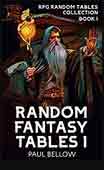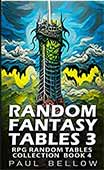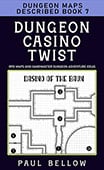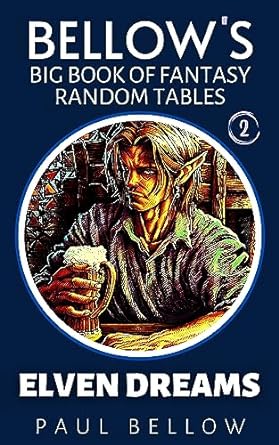Gone are the days when D&D heists (and other random fantasy encounters) clung to railroad tracks and followed rigid blueprints. A reactive campaign seethes and shifts under the weight of every rogue step and silenced guard, electrifying the table with anticipation and possibility. Instead of letting your story lurch along to a script, a truly responsive world pulses in tandem with your players’ wildest gambits, folding their choices into the very fabric of the narrative. The heist scenario proves perfect ground for this kind of storytelling, a place where every lock picked, lie spun, or alarm tripped reshapes not just the room, but the night’s entire momentum.
Linear stories place agency far on the horizon. Players bump into invisible walls, their plans hemmed by a DM’s predetermined script. In a reactive heist, every action casts ripples that ebb and crash through security networks, NPC alliances, and city gossip. Tension ratchets skyward, engagement sharpens, and players lose themselves in the constantly shifting puzzle box you construct with them, not just for them. The improvisational nature of the heist isn’t an accident, it’s a feature. A world built on consequence dares players to raise the stakes and surprise even themselves.
The thrill erupts when players realize the city’s pulse synchronizes with their own. Shadows lengthen and doors close not because you decree it, but because they made a call, sparked a rumor, or left a subtle trace behind. A linear plot whispers, “watch me tell a story.” A reactive heist crackles with “change my world if you dare.” Every route matters, every mistake echoes, amplifying immersion until even a single footstep could tilt the outcome. Investment in the story soars, transforming familiar skill checks into moments that matter.
In the pages to come, you’ll unlock the secrets behind forging this kind of living, evolving narrative. You’ll see how to entwine logic, preparation, and improvisation, creating a city that moves, breathes, and occasionally sweats right alongside your players. Step inside. Let’s crack the vault on the true magic of dynamic heist campaigns, a place where the dice spin and the world watches, ready to pivot at a moment’s notice. And if you need top shelf RPG AI tools, we’ve got you covered too.
Understanding Reactive Heist Dynamics
Built on meaningful choices and visible consequences, a reactive heist campaign draws its power from the simple, immutable principle that actions matter. Every move your players make is a brushstroke on the canvas of the night, visible to allies and adversaries alike. The DM’s role morphs from puppeteer to conductor, synchronizing the chaos of player decisions into a coherent and electrifying narrative symphony. No lock, no guard, no whispered rumor exists in stasis, every element alive and waiting for a spark.
Improvisation becomes your lifeline. Prepped flexibility keeps you nimble, ready to chase cunning thieves down forgotten corridors or negotiate with a suddenly suspicious merchant. Adaptive storytelling thrives on cause and effect, not mere chance. When a hand brushes the wrong idol or a disguise slips, the world must react; not arbitrarily, but in ways that make sense, build pressure, and tempt risk. The satisfaction for players lies in seeing the immediate and rippling aftermath, knowing the world bends (but never breaks) around their schemes.
Try my AI Tabletop RPG generators...and an extensive library of content!
Campaigns that lean hard into this dynamic tension reward creativity. As tension mounts, even routine encounters burn with uncertainty. Silent alarms may hum as a backdrop to mundane conversation, a guard’s path veers off pattern, or an old rival receives word whispered onto the thieves’ grapevine. Player ingenuity explodes when they see the world as a system with gears and levers that truly move. Knowing a choice at midnight alters dawn’s outcome, players push boundaries, test flaws, and invent new ways forward.
Worlds built on reaction become intricate playgrounds. The city isn’t simply a backdrop. It emerges as a character in its own right, an adversary, a prize, or an ally, depending on who’s pulling strings. Reactive heist dynamics deepen every exchange, sharpen every dilemma. Instead of guessing “what does the DM want?” players wonder, “what happens if I try this?” Those wonders are the fuel. The campaign transforms from a scripted play into a living, collaborative puzzle.

Building a Responsive World for Your Heist
Start with touchpoints, not corridors. Pinpoint where players can tangle with the world: security checkpoints; shift changes; drunken guards; jealous lovers; backroom handoffs; city-wide comm relays. Each becomes an interaction node ready for tampering, bribing, or exploiting. Prepare them not simply as obstacles, but as layered mechanisms: each with visible states, hidden triggers, and plausible outcomes. The city waits, poised to respond.
Triggers aren’t traps for the unwary. They’re invitations to ripple, designed as logical cause-and-effect hinges. A foot slips, a gem vanishes, an alias slips under the wrong nose, something shifts. Your preparation pivots on three key details: what triggers the reaction, what force unleashes, and how those forces manifest in ways players can sense. Avoid randomness for its own sake. Instead, let the world breathe through visible systems and naturally escalating responses.
⚔️ Fantasy RPG Random Tables Books
Make life as a Gamemaster easier…
If you play Dungeons & Dragons, Pathfinder, or other fantasy RPGs, this
RPG random tables series
is packed with encounters, NPCs, treasure, and more. Available in eBook or print—either way, you’ll have a wealth of adventure ideas at your fingertips.
Reactive doesn’t mean chaotic. Clarity and logic guide you. If the alarm sounds, city guards don’t teleport; they scramble, reroute, leak anxiety into civilian patterns, and perhaps even call on old debts. Each reaction radiates consequences through believable networks: a door that’s unlocked becomes watched, a trustworthy fence grows wary, a familiar face refuses aid. Players piece together the chain of outcomes, quick to adapt or double-back.
For every point of contact, envision two or three forked responses; some lenient, some severe, all dependent on how slick or brash the players run. Let each outcome reverberate elsewhere: a missed window might lead to a new informant’s tip, or an overzealous heist spooks rival crews. Every change reshapes the board, tick by tick, until the once-static world feels as restless and cunning as the thieves themselves.
Twelve+ Narrative Triggers and Reactions
- Disabling a security alarm causes backup guards to patrol new routes with raised suspicion.
- Lockpicking a noble’s safe without covering tracks spawns a city-wide investigation, prompting merchants to tighten their security policies.
- Bribing a minor official plants rumors, resulting in trusted informants fleeing or demanding more gold.
- Spilling blood in a no-violence zone drives local gangs into open war, forcing players to cross newly dangerous territory.
- Stealing a rare artifact triggers magical wards that notify supernatural investigators.
- Failing a disguise check in front of a house servant results in the servant later leaking suspect descriptions to the city watch.
- Planting fake evidence in a rival’s room leads to that rival being arrested and interrogated, disrupting faction politics.
- Freeing a captive NPC during the heist means the grateful person later warns players of future traps or betrays them to save their own skin.
- Burning an exit route by starting a fire causes the entire neighborhood to lock down, closing off escape and filling the air with smoke.
- Failing to silence a nosy neighbor results in word rapidly spreading through the criminal underworld by dawn.
- Replacing stolen goods with substitutes fools guards for a time, but sharp-eyed investigators spot flaws, accelerating their pursuit.
- Picking up a banned magical device draws attention from arcane regulators who shadow the party through future sessions.
- Giving conflicting stories to different NPCs triggers paranoia and surveillance, with informants tailing the party for several days.
- Double-crossing a fence leads to assassination attempts or blackmail demands in later scenes.
- Smuggling a heist item through customs seeds suspicions; officers become increasingly intrusive at future checkpoints.
Consistency and logic anchor every shifting facet. Each ripple starts somewhere, leaps through believable channels, and lands with impact. Players learn to sense the order beneath the mayhem, rewarding deep planning and heightening immersion with every move.
Only logical, trackable shifts deepen engagement. Keep reactions within the established web of relationships, security networks, and city routines never step so far that your world feels arbitrary or capricious. In this way, the campaign’s complexity serves your story, not chaos. Players recognize their hand in every tightening net and slipknot, investing wholly in the game’s living world.

Preparing Adaptive Challenges
Encounters must breathe alongside your players. The same security checkpoint might offer a different thrill to slick-tongued charmers, nimble shadows, or firebrand bruisers. Plan modules like puzzles with interchangeable pieces, not brittle blueprints. If the party uses distraction, add an extra shift change; if they go loud, reinforce with heavily armed sentinels; if they bribe, let the ripple pass quietly, but spike prices for future bribery.
Outline key scenarios, leaving their internal logic loose enough to bend without snapping. For every vault guard, consider their threshold for bribery, alertness to magic, or family ties that can be leveraged. If the players split the team, design challenge fragments, some can only be solved solo, but might trigger complications for the rest. The challenge evolves with the approach: stealth invites cunning countermeasures, negotiation unearths hidden knowledge, violence reorders loyalties.
A table of prepped challenge modules (labeled by type, default setup, player-driven alteration, and DM response) keeps your improvisation sharp and plausible. The more you slice encounters into adaptive pieces, the more alive each session becomes. Holistic prep allows you to swap out foes, change patrol routes, or escalate stakes on the fly, always crediting player ingenuity.
Mobility in design empowers your players. If they can see how their tactics change the board, every victory and failure lands with weight. They puzzle over how to slip a document past a nosy clerk or dodge a warforged patrol, knowing a creative use of fog or enchantment opens new routes or closes them forever.
Encounter Adaptation Table
| Encounter Type | Initial Scenario | Player Choice Alters Scenario | DM Reactive Adjustment |
|---|---|---|---|
| Stealth | Standard guard route, regular patrols | Players use magical silence | Guards bunch into one group, change route |
| Combat | Single security golem stationed in hallway | Party attempts intimidation | Golem calls for backup, alarms triggered |
| Social | Merchant reviews credentials at entry | Player bluffs noble status | Merchant consults hidden directory, stalls |
| Stealth | Window left slightly open in upper floor | Thief leaves evidence inside | Next visit, window is barred and alarmed |
| Combat | Rival crew mapped on rooftop awaiting fight | Players ambush with traps | Rivals split forces, retaliate in future |
| Social | Bribed janitor at casino hushes up intrusion | Players threaten blackmail | Janitor tips off casino management |
| Stealth | Magical sensors covering gallery | Party disables sensors with spell | Extra magical wards deployed next night |
| Combat | Armed guards patrolling artifact chamber | Players retreat after first exchange | Guards set traps, double night watch |
Flexibility weaves player creativity into the city’s fabric. Swapping modules, shifting responses, and rewarding unexpected ideas keep momentum surging and players hungry for the next twist.
Players thrive when the pathless world rewards them for unorthodox thinking not by flattening every challenge, but by reflecting their wit with fresh obstacles and clever openings. The tension between improvisation and design becomes a crucible, forging unforgettable nights around your table.
⚔️ Fantasy RPG Random Tables Books
Make life as a Gamemaster easier…
If you play Dungeons & Dragons, Pathfinder, or other fantasy RPGs, this
RPG random tables series
is packed with encounters, NPCs, treasure, and more. Available in eBook or print—either way, you’ll have a wealth of adventure ideas at your fingertips.
Running Reactive NPCs and Organizations
A living world spins on the faces and motives behind each heavy door. NPCs and factions sculpt the rhythm of your heist, their desires ever-complicated by relationships, secrets, and pride. Individualizing these characters transforms challenges into nuanced, volatile puzzles every trusted ally a potential turncoat, every casual acquaintance a dormant threat or unexpected lifeline. Reactivity isn’t just for alarms and guard routes; it lives in whispered exchanges, shifting loyalties, and the burning gaze of disappointed mentors.
Equip major NPCs with vivid secrets and clear ambitions. What do they want? What lines will they cross, and for whom? How do they react to betrayal, bribery, or success slipping through their fingers? Let their personalities and moods flex as the heist evolves. A fence scorned might sell your secrets; a rival thief impressed by your daring might seek partnership when you least expect it.
Organizations mix paranoia with pride. Crime syndicates shift allegiance in the night, temples close their sanctuaries, and merchant guilds raise bounties, all in response to ripples your players start. When a rumor races through the city streets about three masked thieves at the dice tables, watch as alliances fracture and bargains skew. Dynamic relationships drive intrigue. Each NPC is both a hinge and a lever, their reactions kaleidoscoping your planned story into a web of surprise.
Let information flow naturally. If word of the heist leaks, loyalists might lay low, tempers might fray, or competitors might gamble everything for a final score. A true living world hums with the constant churn of motives vengeance, fear, greed, ambition. Map out not just how someone reacts in the moment, but how their reactions reverberate days or even sessions later, haunting the players with the gravity of their choices.
Fourteen+ Reactive NPC or Organization Examples
- The local thieves’ guild tightens recruitment, demanding loyalty tests after a botched heist.
- A rival crime boss posts a massive bounty for information, attracting every lowlife hustler in the city.
- An informant secretly betrays the crew to the city watch, hoping for leniency on their own criminal record.
- An old friend, believed loyal, severs ties when a player’s violent methods cross a hidden moral line.
- The local fence raises prices, making future jobs riskier and less profitable.
- A high priest denounces the party in coded sermons, while secretly blessing them as folk heroes to the desperate.
- Disillusioned guards form a vigilante task force after repeated heists, operating outside official law.
- A black market merchant closes shop, leaving players scrambling for new contacts.
- A romantic partner of a PC flips allegiance, seduced by a rival thief’s promise or gold.
- The security chief grows suspicious, doubling magical defenses and issuing open challenges to catch the party.
- A noble patron, once a silent sponsor, fears scandal and cuts off support when their name surfaces in rumor.
- Rival thieves coordinate their own heist, hoping to outscore your crew on the same night.
- Distrust and rumors spark an underworld civil war, blocking access to crucial black market goods.
- A gambler working for the casino leaks inside information after losing to the party’s rigged games.
- A retired thief comes out of hiding, offering cryptic guidance and dangerous favors if the party helps with a personal vendetta.
The campaign world swirls, thickening with intrigue as NPCs and organizations respond to player successes and failures. Immersion intensifies when every character and institution moves with purpose, shaped by moments players recognize and regret.
Sustained campaign energy lies in authentic evolution. When players know the world reflects their hand at the wheel, trust in the unfolding story solidifies. The reactive web ties every betrayal, every secret, and every alliance back to the night’s original spark.

Tools and Techniques for Managing Reactivity
Complexity breeds chaos only when left untamed. Organizing the many branches and ripples of a reactive world demands discipline and a suite of practical tools. The best DMs find their own rhythms, blending technology with old-school note cards to chart the shifting tides of consequence and intent. Start simply with a timeline, a consequence map taped to the underside of your screen, or a stack of sticky notes for every trigger. Layer complexity only when clarity remains.
Digital tools grease the wheels. Mind-mapping apps, branching story trackers, even basic spreadsheets serve as lifelines for the over-caffeinated campaign architect. Color coding, icons, and succinct summaries let you spot hidden dangers and alluring opportunities buried in the campaign web. The act of visually mapping relationships clarifies which elements require prep, which can be left to improv.
Communication with players forms the final pillar. A world ablaze with consequence needs firm signposts. Use session recaps, visible NPC behavior, and in-character rumors to show how the city’s mood has shifted. If an old rival has become an ally, let the players know through an encounter, a letter, or a cryptic warning from a street urchin. Tracking isn’t just for your own sanity; it’s the feedback loop that invests players deeper into your world.
Tracking Player Decisions and Consequences
Vigilant record-keeping ranks among the highest arts for the reactive DM. Every meaningful choice leaves residue in the campaign. Whether with index cards, digital trackers, or annotated city maps, organize player actions by type, context, and lasting consequences. Streamline your approach; overcomplexity saps energy and risks losing sight of the cascade.
Timeline tools capture the when and where. Mapping out “cause: effect” ensures you never lose track of why the city guard is chasing the party three sessions later. Consequence maps, literal or digital, visualize which actions tangled which NPCs, which organizations, and which locations. Use symbols to denote fractured trust, rising heat, or quiet opportunities seeded for later payoffs.
Try my AI Tabletop RPG generators...and an extensive library of content!
Story trackers balance brevity and clarity. When in doubt, jot a three-line summary: “Heist at Grand Casino: Guard bribed, alarm silent, suspicious waiter watched. Waiter tips off rivals. Rival ambushes party in next session.” Portable, dynamic summaries like these prove invaluable during both prep and improvisation, letting you consult or adjust on the fly without derailing pacing.
Precision, not excess, rules your method. Focus on decisions that fundamentally alter the world, ripple through character relationships, or open/close doors for the heist. Dead ends and dead air breed confusion. Cull trivial notes; foreground the choices that sing, those with teeth, memory, and deep consequences.
Tracking Table: Player Decisions and Consequences
| Decision Type | Tracking Method | Possible Future Outcomes |
|---|---|---|
| Stealth break-in | Timeline, map | Guard rotations altered, security raised |
| Buying off NPC | Note-taking | NPC expects future bribes, becomes asset |
| Open confrontation | Timeline | Organization places bounty on party |
| Forming alliance | Network chart | New resource access, enemy suspicion |
| Spreading rumors | Note-taking | Factions split, false leads created |
| Killing rival | Timeline | Family seeks revenge, underworld destabilized |
| Forgery/disguise | Note-taking | NPC mistrust, access to restricted areas |
| Hostage-taking | Timeline, chart | Aggressive negotiations, heightened pursuit |
| Blackmail | Network chart | Power shift in organizations |
| Ignoring clue | Map, timeline | Missed opportunity, rival claims reward |
Smooth tracking underpins your credibility. Players trace their victories and defeats, trusting in the campaign’s logic and in your power as narrative architect. Consistency and memory fuse to deliver consequences that feel both inevitable and surprising.
The long arc of consequence stretches across sessions and weeks. Tidy tracking means choices never vanish; each return, echo, and callback deepens the mythology of your world and the legend of your players.
Balancing Reactivity and Story Control
Having a living world doesn’t mean sprinting off a cliff. The craft lies in deliberate tension between freedom and narrative anchor. While every decision matters, key story beats must still arrive. Loose rails replace rigid tracks: the direction set, but the means and mood determined at the table. The DM remains guide, not jailer, coaxing structure from the wild rhythm of consequence.
Plot checkpoints serve as landmarks. These narrative moments can flex in their timing or flavor, but their arrival locks in the campaign’s real stakes, a meet with the fence, a showdown at the vault, a desperate chase. Story coherence persists through these anchors, regardless of how circuitous the route. Unlike railroading, checkpoints respect player ingenuity while protecting the integrity of your tale.
Narrative funnels taper chaos, steering characters through a web of branching paths toward common climactic events. Flexible goals, contingency plans, and secret fail-safes hide in plain sight, waiting to spool out when a session careers into uncharted territory. By offering several paths forward but guaranteeing certain milestones occur, you prevent campaign sprawl from cannibalizing itself.
Player trust builds on this equilibrium. They savor control while you maintain the gravity and pacing that make the story sing. Together, you unspool a drama nobody could have predicted, yet each moment feels inevitable. The illusion of total openness conceals your deft hand, folding chaos into coherence.
Techniques for Balancing Control and Freedom
- Plot checkpoints: anchor moments all paths converge toward.
- Narrative funnels: wide options narrowing to crucial events.
- Flexible goals: allow multiple solutions and approaches.
- Hidden contingency plans: backup routes mapped for wild outcomes.
- Timed events: in-world clocks force pivotal moments.
- Modular encounters: swappable scenes fitting any approach.
- NPC-driven nudges: allies steer players toward crucial info.
- Flashbacks and foreshadowing: seed later anchors early.
- Environmental cues: physical realities (sunrise, festival) lock pacing.
- Fail-forward design: no dead ends, only changed complications.
- Dynamic objectives: objectives that shift in response to the world.
- Player-driven subplots: let character arcs pull toward main plot.
- Recurring rivals/antagonists: create ongoing foils linking events.
Mastering this balance keeps players spellbound while allowing you to play conductor. Everyone wins: the story deepens, their agency sharpens, and memorable campaigns flourish.
Above all, trust your players. Let them surprise you, let the story flex. Keep the story’s spine intact, but weave a thousand branches. The resulting tapestry becomes richer, stranger, and more human than any rigid script could ever produce.

Reactive Heist Examples in Practice
Imagine the Thieves’ Ball spiraling from a simple snag-the-jewel job into a web where secrets, violence, and betrayal trade places with every whisper. One night, a rogue bribes a guard, only to have that guard tip off the rival crew. The players, thinking they’ve secured silent passage, instead walk into an ambush, the city’s criminal grapevine suddenly buzzing. Word explodes through taverns, alliances buckle, and the once-staid nobles panic.
Scenarios birth new consequences as the city and its denizens seize on opportunity and chaos. When a player bluffs their way into a masquerade, only to inadvertently insult a masked prince, the fallout ripples into new knight patrols, citywide suspicion, and a mid-heist duel. The players pivot, forced to devise makeshift plans under new rules and threats. Every cool calculation becomes a hotbed of improvisation.
A successful networked campaign lets each creative deviation seed new challenges. For example, a party plants false clues to throw off guards, but clever investigators cross-check details, following the trail straight to their next safehouse. The crew burns the next few jobs in a haze of paranoia. Guards don’t simply forget, the world remains ever-watchful, every decision carving a new branch of consequence and opportunity.
⚔️ Fantasy RPG Random Tables Books
Make life as a Gamemaster easier…
If you play Dungeons & Dragons, Pathfinder, or other fantasy RPGs, this
RPG random tables series
is packed with encounters, NPCs, treasure, and more. Available in eBook or print—either way, you’ll have a wealth of adventure ideas at your fingertips.
Reactive campaigns live and die on authenticity. A single shout on a rooftop draws a city’s worth of night-watchers. A fence’s betrayal sends players crawling through sewer pipes and grimy tavern corners, re-establishing alliances, shifting tactics, and always, always searching for an edge. These moments elevate a heist into legend.
Reactive Heist Example Table
| Scenario Description | Player Decision | Immediate Narrative Reaction | Long-term Campaign Impact |
|---|---|---|---|
| Bribing a vault guard | Guard accepts bribe | Rival crew notified | Guards replaced, bribery riskier |
| Losing a note with the plan in a tavern | Local reads note, sells info | Alerted guards change routine | New patrol routes, party under suspicion |
| Blundering a disguise in front of noble | Tries to bluff noble | Noble insulted, calls for duel | City watch scrutinizes party |
| Planting fake evidence in rival’s room | Evidence discoverable | Rival arrested, house upturned | Rival’s allies seek answers, vendetta |
| Starting a fight during a gala | Flees rather than finish | Gala in chaos, guests panic | Banned from high society |
| Stealing magical artifact, tripping ward | Fails to dispel properly | Wards notify arcane investigators | Magical surveillance stalks party |
Patterns emerge. The best reactive moments create new webs from simple decisions; what starts as a single thread transforms into a tapestry of risk, surprise, and triumph.
Success breeds success. As new branches open, players learn to think three moves ahead, adapt to a living world, and immerse themselves in a city that rewards innovation. Story arcs deepen, memories root, and every session becomes a story worth retelling.
Common Pitfalls in Reactive Campaigns
Overcomplexity shadows reactive campaigns like a black dog. The urge to prepare for every possible branch threatens to overwhelm even seasoned DMs, throttling momentum and drowning vital moments in endless notes. When the world spins too wild and unchecked, narrative confusion seeps in and players lose their sense of agency, subsumed by a web that no longer reflects their choices. Pacing suffers, and with it, the thrill.
Confusion poisons immersion. If consequences seem arbitrary or logical connections warp, the campaign slides into chaos. Players want surprise, not senseless upheaval. Lack of clarity leads to dissatisfaction. Narrative threads unravel, antagonists contradict earlier behavior, and crucial moments lose their sting. Preparation and method unconsciously slip, and the magic of the reactive world falters.
Solutions begin and end with discipline. Develop lean, adaptive planning habits. Prioritize the most important ripple points, regularly recap shifting dynamics with players, and keep your consequence map up to date. If the campaign starts to wobble, pull back, clarify cause and effect, and use anchor point events to realign the city and its players. Brevity and clarity, spiked with logic, empower the most thrilling sessions.
Mistakes to Avoid in Reactive Play
Inconsistency tanks believability. If NPCs forget previous betrayals or guards ignore alarms, players recognize the hollowness underneath the facade. Premature improvisation unravels the tapestry, creating nonsensical outcomes. Overly rigid scenarios crush creativity, stripping the campaign of its ensemble dynamism.
Failure to communicate the world’s reactions hurts player investment. A consequence unseen is a consequence wasted; always show outcomes, not just note them behind the screen. If plot twists hit without clear triggers, players feel railroaded, not rewarded for choices.
Twelve+ Pitfalls in Reactive Campaigns
- Improvising major events without backup plans.
- Inconsistent NPC motivations and relationships.
- Neglecting to show consequences in-game.
- Poor communication of shifting world dynamics.
- Introducing plot twists without player input or trigger.
- Letting tracking fall behind pace of campaign.
- Over-preparing, bogging down in complexity.
- Ignoring player ingenuity to steer toward planned outcomes.
- Relying on random chance instead of logical cause and effect.
- Not giving players time to adapt to new circumstances.
- Failing to close narrative loops, leaving hanging consequences.
- Letting campaign timeline slip into incoherence.
- Neglecting emotional throughlines or character arcs.
Preparation and player-focused planning stave off disaster. By checking campaign logic, openly tracking consequence, and highlighting player impact, DMs support the intrigue and energy of the living world.
When problems arise, retreat to the basics: clear signposts, honest dialogue, and ruthless focus on meaningful decisions. The reactive campaign only falters when its own rules are forgotten.

Final Thoughts: Mastering Reactivity for Memorable Heists
Reactive D&D heist campaigns radiate a unique, exhilarating tension; no static puzzle, no rote sequence of locks and keys. Every plan, panic, and pivot shapes a living city, a breathing cast, a legend in constant flux. When players control more than their dice, storytelling flowers into a communal, electric experience.
Mastering reactivity means letting go of certainty. Trust your prep; trust your method; trust your players. The best moments emerge not from the script, but from the sparks and collisions of ambition and fear. Allow the world to push back, to grow paranoid, to blink when the unexpected strikes. In the symmetry of agency and logic, suspense holds fast.
Each success emboldens the table to dive deeper; players experiment, improvise, and collaborate, knowing their choices matter. Consequence becomes the campaign’s true treasure; immersion, its rarest prize. Gaming transforms: not just playing at thieves and villains, but living the pulse of an ever-shifting, neon-lit world where every second counts.
Experiment boldly. Let stories shift beneath your hands. When you embrace dynamic reactivity, you don’t just tell a tale, you build a world with your table, every session a new legend, every memory a mark left on the city’s dark, gleaming heart.










